Paralake Penal Code
Section 1: Terminology
Unless otherwise stated, all articles in this Penal Code are criminal offences that render a person liable for legal action such as fines, arrest or detention.
Whilst reading the Paralake Penal Code certain words, phrases and concepts are used in order to be broadly applicable to a range of laws. This section shall detail such words, phrases and concepts and will define each term within the context of the Penal Code.
All of the following definitions are strictly meant to only be understood as definitions only within the context of this Penal Code.
Public is the populous of Paralake City
Property is the area in or around the building itself as defined by the deed held by the banks of Paralake City
Possession is a person’s belongings or an object owned by a person or entity such as the Government of Paralake City.
Emergency Services refers to the Paralake Police Department, Paralake Emergency Medical Service and the Paralake Fire Department collectively and the individuals that make up these services.
Law enforcement officer is any sworn member of the Paralake Police Department.
Government Employee refers to anyone employed as a Law enforcement officer, Paramedic, Roadcrew Worker, Firefighter, Secret Service Agent or has been elected into a public office.
Dishonesty is acting in a deceitful manner such as lack of integrity or strongly held moral principles contrary to good faith.
A Vehicle is any object that enables mobility other than by movement on foot.
A Public Area is an area in which any member of the public can gain access without restriction
A Public Setting is any location that can be seen unobstructed from a public area such as inside rooms with windows facing a public area.
Public Property is any property under the ownership of Paralake City or other governmental agencies.
Private Property is any property under the ownership of a private individual purchased from one of the banks of Paralake City.
Publicly Restricted Area is any area of a property which is not intended to be accessible by the public.
The term or is taken logically to mean at least one option of all options stated.
Capacity is a person’s ability to understand the situation they are in and any consequences for their actions. A person is unable give consent if they lack capacity.
Consent is express permission from another person to carry out an action.
Restricted Substances refer to any raw substance or derivative such as seeds, food products or aerosol sprays that contain an active substance that causes a strong physiological change in the body with the exception of products that may be purchased over the counter or prescribed for medical purposes. This term excludes alcohol, tobacco (nicotine) and caffeine. Common examples include cannabis, cocaine, methamphetamines, LSD, and heroin.
Asset Forfeiture refers to where LEOs have the power to seize items that are related to a criminal offence.
Police Supervisor an officer ranked Sergeant or above.
Parking Road Markings Two white lines in parallel with a reasonable amount of space between them to allow successful entry with of a vehicle. Vehicles parking here must be parallel to the road markings defined.
Arrest Process of taking custody of an individual who is involved, or suspected of being involved in a criminal offence so more information can be gathered by an investigation.
Probable Cause To have knowledge with facts that it is more likely than not that a criminal offence has been committed and that, if presented with the same facts, a reasonable person would draw a similar conclusion.
Unroadworthy condition A vehicle that has sustained such damage that a driver is prevented from having complete and safe control of the vehicle. A vehicle is unroadworthy if any vital components are not operating correctly, including, but not limited to, speedometers, indicators, tyres, headlights.
Emergency Vehicle refers to any vehicle under possession by any entity listed as part of Emergency Services and operated by a member of Emergency Services.
Charge Declaring someone guilty of an offence(s) which has been proven without reasonable doubt and through solid evidence
Section 2: Right to Self Defence and Necessity
Any action performed under this section that is contrary to the law that results or is likely to result in death or injury of a person, or damage to property or possessions must be reported to emergency services as soon as it is practicable to do so.
2.1 Self Defence and the Defence of Others
Any person may use a justifiable amount of force proportionate to a threat if they reasonably believe that such force would prevent great bodily harm or death.
2.2 Necessity
If a person reasonably believes that acting in a way contrary to any law, with the exception of 9.5, is necessary to prevent injury or the loss of property they do not act unlawfully given that their actions are justifiable and proportionate.
Section 3: Powers of LEOs, Security Services and Elected Officials
3.1 Right to Arrest
Law enforcement officers may arrest any person who has committed or by probable cause has been suspected of committing a crime. This allows for information to be gathered by an investigation. If enough evidence has not been provided to charge the individual; the individual must be de-arrested and released as soon as it is practical to do so.
3.2 Right to Charge
Law enforcement officers may declare someone guilty of an offence(s) by charging them with a crime which has been proven beyond reasonable doubt and through solid evidence (i.e. DNA proof, government witnesses, admissions of guilt. Civilian witness statements alone do not amount to solid evidence). There is no requirement that a charged person has to be imprisoned. When charging someone, the suspect can request a Supervisor (if available) to have their input on the matter.
3.3 Use of Force
Law enforcement officers may use any amount of force in the execution of their duties provided that it is reasonable and justifiable.
3.4 Issuing of Arrest Warrants
The Paralake Police Department may issue a warrant for a person’s arrest, if the officer requesting the warrant holds reasonable belief that the individual named in the warrant has committed a criminal offence.
3.5 Issuing of Search Warrants
Search Warrants are only required for properties which are inhabited by private individuals. A search warrant may only be issued for a property when the issuing Law enforcement officer reasonably believes that a crime has been committed and or is currently in the process of being committed on the property.
3.6 Right to Stop and Detain
A Law enforcement officer has the power to stop any vehicle that has been used in and or is carrying or being driven by a person who is believed to have committed a crime and or is believed to be in the process of committing a crime. A Law Enforcement Officer may also stop any person who is believed to have committed a criminal offence or is in the process of committing a criminal offence. During this time the officer may detain the person(s) involved until the conclusion of the investigation into the offence in question.
3.7 Right to Search
Law enforcement officers may search a vehicle and/or storage container belonging to a detained person if it is believed that the vehicle contains evidence which is believed to be related to a crime that the Law enforcement officer has reasonable belief has been committed inside the vehicle and or a crime in which the vehicle has been used, a Law enforcement officer may also search any person who is detained for anything that the detained person is believed to be in possession of relating to the investigation for which they are detained, Law enforcement officers may also search any arrested person in their custody for any evidence of a criminal offence.
3.8 Right to Enter Private Property
Emergency Service workers may enter any private property if it is necessary for the execution of their duties. Emergency Service workers may not remain on a Private Property if asked to leave by the property owner unless this would obstruct an investigation into a criminal offence or the prevention of serious harm to or death of any person. Any Emergency Service worker who fails to do so commits the offence of trespassing.
3.9 Right to Restrict Entry to Public Places and Private Property
Law enforcement officers may restrict access to any place whether public or private if this would aid the Paralake Police Department in the execution of their duties. If an access to an area larger than one residential property is to be restricted for longer than 10 minutes authorisation from the most senior Law enforcement officer on duty must be sought. Any person who fails to comply with an order from a Law enforcement officer to leave an area commits the offence of failing to comply with a direction to leave notice.
3.10 Punishments
Law enforcement officers have the power to punish government employees and members of the public, however they must follow the provided punishment below each law, punishments listed are maximum penalties. Permission must be gained by a Lieutenant or higher if an LEO wants to go above the provided maximum punishment. The use of Capital Punishment is not permitted.
3.11 Cooperation with other agencies
The emergency services of Paralake are obliged to cooperate and work jointly. No other organisation or person shall be permitted by any government agency to take an active role in an incident if this would endanger their safety, unless authorized by a member of Police Command.
3.12 Secret Service Powers
Secret Service agents employed by the government to protect the mayor hold the powers of an LEO when the safety of the mayor is in direct and imminent danger. Secret Service agents must inform the police if they use any of these powers at the earliest possible opportunity.
Secret Service agents hold the same rank as the hold in the PLPD, and therefore must abide by the policies of the PLPD. Secret Service agents are accountable to Police Supervisors and the Professional Standards Department in the PLPD.
3.13 Illegally or Improperly Obtained Evidence
Illegally or improperly obtained evidence is evidence obtained in violation of a person’s human rights or obtained in breach of the law, policy or procedure - and it would be unfair or unjust to use it. All charges related to this evidence must be dropped under this law, but any items related to the offence may still be seized by police under asset forfeiture.
Section 4: Emergency Services or Elected Officials Conduct
4.1 Law-Enforcement Officer’s Discretion
Law enforcement officers hold a certain power of discretion over any issue however this may be overruled by a higher ranking officer. Any officer of any rank who misuses their power of discretion without holding the best interests of the City into account commits an offence under article 4.4.
4.2 Duties of a Law enforcement officer
Any Law enforcement officer who fails to carry out any of their duties to the best of their ability commits the offence of failing to carry out duties and is liable for punishment. Duties of a Law enforcement officer include but are not limited to acting in the best interests of the city, acting in accordance with the Paralake Police Department Code of Ethics, acting in accordance with any orders given to them by a Law enforcement officer who is senior in rank and acting in the safest way possible.
4.3 Exemption from Law
A government emergency service worker does not act unlawfully if their actions are contrary to any law and their actions are reasonable, justifiable and proportionate and are necessary for the effective execution of their duties.
4.4 General Misconduct in a Public Office
Any elected official or government employee who acts dishonestly and or not in accordance with the best interests of the city commits the offence of misconduct in a public office.
4.5 Ransom Payments
No ransom shall be paid by the Paralake Police Department unless authorised by the highest ranking officer on duty and it shall not exceed the amount of $5000.
4.6 Confiscation
No weapons or evidence shall be confiscated by Law Enforcement when immediate harm is at risk, such as under gun fire or assailants nearby. Evidence is permitted to be confiscated if the officer is unable to watch over the evidence and leaving it where it is would risk it being tampered with by a member of the public.
Section 5: Financial and Identity Crime
5.1 Tax Evasion
Any person who actively evades and or assists in the evasion of any government tax where it would otherwise be paid acts unlawfully.
Felony - liable to 2 years maximum imprisonment, $3,000 maximum fine and asset forfeiture.5.2 Bribery
No person shall attempt to offer or solicit personal payment in any form to any member of the emergency services or an elected official in order to receive immunity, preferential treatment or other such dishonest benefits.
Felony - liable to 3 years maximum imprisonment and $4,000 maximum fine.5.3 Identity Theft
It is an offence to impersonate another person through any means with the intent of committing or concealing a criminal offence or in order damage their reputation.
Felony - liable to 3 years maximum imprisonment and $4,000 maximum fine.5.4 Fraud
No person shall deliberately deceive another person with the intention of unlawfully depriving them of money, possessions or property.
Felony - liable to 3 years maximum imprisonment, $4,000 maximum fine and asset forfeiture.5.5 Blackmail
Any person who uses information as a form of leverage in order to threaten a person legally, financially, or otherwise, in return for their respective cooperation with any form of demand commits an offence.
Felony - liable to 5 years maximum imprisonment, $4,000 maximum fine and asset forfeiture.5.6 Impersonating Emergency Services or Government Official Personnel
No person should impersonate Emergency Services or Government Official personnel unless they hold a position in either institution.
Felony - liable to 3 years maximum imprisonment and $4,000 maximum fine.5.7 Extortion and Racketeering
It is an offence to attempt to extort money, services, favours, or possessions from others through coercion, intimidation or other menacing behaviour.
Felony - liable to 4 years maximum imprisonment, $4,000 maximum fine and asset forfeiture.Section 6: Cooperation with Emergency Services
6.1 Provision of False Information
Any person who when asked for information or when offering information to emergency services presents information which is not truthful and complete commits an offence
Misdemeanor - liable to 3 years maximum imprisonment and $2,000 maximum fine.6.2 Destruction of Evidence
No person shall tamper with, destroy or hide evidence relating to a criminal offence.
Felony - liable to 3 years maximum imprisonment, $3,000 maximum fine and asset forfeiture.6.3 Aiding & Abetting
Any person who knowingly provides assistance to a person in preparation or execution of a criminal act, or to any person under detainment, arrest or warrant for arrest other than providing medical assistance or formal legal consul acts unlawfully. Assistance may be, but is not necessarily limited to advice, action and financial support.
Felony - liable to 5 years maximum imprisonment and $5,000 maximum fine.6.4 Failure to Comply with a Warrant
No person shall fail to comply with the orders detailed within a warrant or obstruct the execution of a warrant.
Misdemeanor - liable to 4 years maximum imprisonment and $4,000 maximum fine.6.5 Cooperation with the Orders of Law Enforcement Personnel
Any person who fails to comply with the legal orders of a Law enforcement officer such as refusing to provide ID when detained or obstructs a Law enforcement officer executing their duties commits an offence.
Felony - liable to 5 years maximum imprisonment and $5,000 maximum fine.6.6 Persons in Need
It is an offence for a person to fail to contact the emergency services when a person is in need of emergency medical care.
Misdemeanor - liable to 3 years maximum imprisonment and $4,000 maximum fine.6.7 Attempting or Planning a Crime
No person shall attempt or plan to commit a crime. A person who does so shall be liable for punishment as if they had committed the offence.
Liable to half of what the offence was if had been committed.6.8 Failure to identify to a Law Enforcement Officer
Any person who refuses to give information or withholds information regarding identification of themselves whilst under detainment by an LEO commits an offence.
Misdemeanor - liable to 2 years maximum imprisonment and $3,000 maximum fine.6.9 Failure to stop for a Law Enforcement Officer
Fleeing or attempting to elude a pursuing LEO commits an offence.
Felony - liable to 5 years maximum imprisonment and $4,000 maximum fine.6.10 Obstruction of Emergency Services
Any person who obstructs a member of the emergency services in their duties commits an offence.
Felony - liable to 5 years maximum imprisonment and $4,000 maximum fine.Section 7: Offensive Weapons
7.1 Fireworks
It is an offence for a person to light a firework within the business, city or suburban areas of Paralake City.
Infraction - liable to $1,500 maximum fine and asset forfeiture.7.2 Possession of Explosives and Incendiaries
It is illegal for a person to manufacture, possess, sell, or transport an explosive or incendiary device.
Felony - liable to 3 years maximum imprisonment, $3,000 maximum fine and asset forfeiture.7.3 Possession of Offensive Weapons
Any person who is in possession of any offensive weapon in a public area without a reasonable excuse commits an offence. Offensive weapons include, but are not necessarily limited to the following, firearms, baseball bats, knives, machetes, or improvised/adapted items with the intent to harm or cause damage.
Misdemeanor - liable to 2 years maximum imprisonment, $2,500 maximum fine and asset forfeiture.7.4 Storage of Offensive Weapons
It is an offence to store an offensive weapon in an insecure place such as a public area or an area easily accessible by the public.
Misdemeanor - liable to 2 years maximum imprisonment, $2,000 maximum fine and asset forfeiture.7.5 Brandishing an Offensive Weapon
It is an offence to brandish, aim, or point an offensive weapon whilst visible from a public area. Any person carrying an offensive weapon on private property and in a controlled manner does not commit an offence under this law.
Felony - liable to 3 years maximum imprisonment, $4,000 maximum fine and asset forfeiture.7.6 Transport of Offensive Weapons
A person does not act unlawfully under articles 7.3, 7.4 or 7.5 if they are transporting an offensive weapon in a way that is direct and immediate between places of secure storage, such as a vehicle trunk or storage chest.
7.7 Sale of Offensive Weapons
A person does not commit an offence under articles 7.4 or 7.5 if the offensive weapon in question is stored or displayed within a property defined by the banks of Paralake City as being a Shop or Business. In addition to this, the offensive weapon in question must be intended for sale to the general public, it must not be being held by any person and must not intended to assist in the committing of any criminal offence.
7.8 Detonation of Explosives and Incendiaries
It is illegal for a person to detonate an explosive or incendiary device.
Felony - liable to 6 years maximum imprisonment and $6,000 maximum fine.Section 8: Restricted Substances
8.1 Possession of Restricted Substances with Intent to Use
Any restricted substance shall be illegal to possess with the intent to use.
Infraction - liable to $1,500 maximum fine and asset forfeiture.8.2 Possession of Restricted Substances with Intent to Supply
Any restricted substance shall be illegal to possess with the intent to supply others.
Felony - liable to 3 years maximum imprisonment, $4,000 maximum fine and asset forfeiture.8.3 Possession of Restricted Substances with Intent to Produce
Any restricted substance shall be illegal to possess with the intent to produce further narcotics.
Misdemeanor - liable to 4 years maximum imprisonment, $4,000 maximum fine and asset forfeiture.8.4 Possession of Restricted Substances with Intent to Transport
Any restricted substance shall be illegal to possess with the intent to transport.
Misdemeanor - liable to 2 years maximum imprisonment, $2,000 maximum fine and asset forfeiture.Section 9: Violent Crime
9.1 Physical Assault
Any person who intentionally or recklessly causes another person to suffer or apprehend immediate unlawful violence commits an offence.
Felony - liable to 5 years maximum imprisonment and $5,000 maximum fine.9.2 Physical Assault with an Offensive Weapon
Any person, who intentionally or recklessly causes another person to suffer or apprehend immediate unlawful violence that is likely to cause great bodily harm through the use of an offensive weapon as defined in law 7.3, commits an offence.
Felony - liable to 8 years maximum imprisonment and $7,000 maximum fine.9.3 Threat of Physical Harm
Any person who causes another person to be in fear of physical assault as defined under article 9.1 by verbal, physical, emotional or other forms of intimidation acts unlawfully.
Felony - liable to 3 years maximum imprisonment and $2,500 maximum fine.9.4 Unlawful Detainment
The detainment of a person against their will unless the person has committed a criminal offence or their detainment is in order to facilitate their apprehension by law enforcement officers.
Felony - liable to 4 years maximum imprisonment and $3,000 maximum fine.9.5 Murder
No person shall take the life of another person with the intent of causing death or severe injury.
Felony - liable to 10 years maximum imprisonment and $10,000 maximum fine.9.6 Manslaughter
No person shall take the life of another person through negligence.
Felony - liable to 7 years maximum imprisonment, $7,000 maximum fine and asset forfeiture.9.7 Sexual Offences
Any person who coerces another person through force, threats or abuse of authority forces another person into performing a sexual act commits an offence.
Felony - liable to 5 years maximum imprisonment and $4,000 maximum fine.9.8 Reckless Endangerment
Any person whose actions put another person at serious risk of harm and / or death are guilty of this offence, regardless of if the endangered person is harmed or not, or if they’re willingly participating in these actions.
Felony - liable to 4 years maximum imprisonment and $4,000 maximum fine.Section 10: Non-Violent Conduct
10.1 Causing Harassment, Alarm or Distress
Any person who engages in persistent behavior likely to cause harassment, alarm, or distress commits an offence. This includes repeated and severe verbal abuse, persistent unwanted contact, or causing public disturbances. Any person who pursues another in a manner likely to induce fear of violence also commits an offence. General insults, criticism of government employees or institutions, and non-threatening remarks do not constitute an offence under this law.
Misdemeanor - liable to 4 years maximum imprisonment and $3,000 maximum fine.10.2 Failing to report a crime
It is illegal for a person who witnesses or has knowledge of the committing of a criminal offence to fail to contact the police as soon as is practicable following the offence.
Felony - liable to 3 years maximum imprisonment and $3,500 maximum fine.10.3 Inappropriate use of Emergency Services
Any person who misuses the emergency services such as by hoax calling the 911 service commits an offence.
Infraction - liable to $5,000 maximum fine.Section 11: Property and Possession Crime
11.1 Obstruction of Property Access
It is illegal to use objects, your person or threatening behaviour to prevent access to either a public area or private property, to a person authorised to enter the area in question.
Misdemeanor - liable to 3 years maximum imprisonment and $1,500 maximum fine.11.2 Vandalism
Any person who damages, defaces or alters a property or possession without the permission of the owner.
Misdemeanor - liable to 2 years maximum imprisonment and $2,000 maximum fine.11.3 Littering
Any person who discards waste material on public or private property commits an offence, unless the property owner has permitted disposal on their property.
Infraction - liable to $1,000 maximum fine.11.4 Trespassing
Any person who enters private property without permission of the owner or publicly restricted area without the use of force or causing damage to possessions or the property.
Misdemeanor - liable to 3 years maximum imprisonment and $3,000 maximum fine.11.5 Burglary
Any person who enters a property or any part of a property with the intention to commit theft, cause unlawful damage or to inflict unlawful serious injury.
Felony - liable to 6 years maximum imprisonment, $6,000 maximum fine and asset forfeiture.11.6 Theft
Any person who dishonestly appropriates any possession belonging to another person commits a criminal offence.
Misdemeanor - liable to 3 years maximum imprisonment, $3,000 maximum fine and asset forfeiture.11.7 Arson
Any person who willfully and maliciously or recklessly sets fire to a property commits a criminal offence.
Felony - liable to 6 years maximum imprisonment and $5,000 maximum fine.11.8 Loitering
Any person who remains in a public area for a prolonged period of time without any apparent lawful purpose commits a criminal offence.
Infraction - liable to $2,000 maximum fine.11.9 Discharging a Firearm
Any person who discharges their firearm in a public or private property, unless for Self Defence and the Defence of Others (see law 2.1) commits an offence.
Infraction - liable to $2,000 maximum fine and asset forfeiture.11.10 Robbery
Any person who steals, and immediately before or at the time of doing so, uses force on any person or seeks to put any person in fear of being then and there subjected to force.
Felony - liable to 7 years maximum imprisonment, $7,000 maximum fine and asset forfeiture.11.11 Aggravated Burglary
Any person who commits a burglary and at the time has with them any firearm or imitation firearm, any offensive weapon, or any explosive.
Felony - liable to 9 years maximum imprisonment, $9,000 maximum fine and asset forfeiture.11.12 Theft of a Vehicle
Any person who steals, takes, or uses a vehicle without the owner’s consent or lawful authority, or knowingly drives or rides in a stolen vehicle, commits an offence.
Felony - liable to 6 years maximum imprisonment, $5,000 maximum fine and asset forfeiture.Section 12: Road Offences
12.1 Jaywalking
It is an offence to enter or cross any part of a highway, or to obstruct the flow of traffic on any public road while on foot. Crossing any road promptly and safely does not constitute an offence under this law.
Infraction - liable to $700 maximum fine.12.2 Speeding
Vehicles may not exceed the posted speed limit on a public road as designated by road signs.
Infraction - liable to $1,500 maximum fine.12.3 Traffic lights
Drivers of vehicles should always come to a complete stop at a red traffic light. The right on red exception permits drivers to pass through a red light if they are making a right turn, providing it is safe to do so. When meeting an amber traffic light, drivers must come to a complete stop if it is safe and possible to do so.
Infraction - liable to $2,000 maximum fine.12.4 Parking
Vehicles may not be parked on public roads, sidewalks, pathways or any other public area not intended for parking unless designated by the parking road markings.
Infraction - liable to $1,000 maximum fine and asset forfeiture.12.5 Road Markings and Signage
Drivers of vehicles must drive in accordance with road markings and signage.
Infraction - liable to $1,000 maximum fine.12.6 Vehicle Maintenance
It is the responsibility of the driver to ensure that the vehicle is free of faults or defects. Any person who drives a vehicle in an unroadworthy condition acts unlawfully.
Infraction - liable to $2,000 maximum fine and asset forfeiture.12.7 Emergency Vehicles
Upon the approach of an emergency vehicle with its lights or sirens activated drivers must pull to the rightmost side of the road to allow the vehicle to pass.If the vehicle remains behind them they must come to a stop at the nearest safe location.
Infraction - liable to $2,000 maximum fine.12.8 Collisions
Drivers involved in a collision with any person or object must stop at the scene of the incident and inform the police of the incident.
Misdemeanor - liable to 3 years maximum imprisonment and $2,500 maximum fine.12.9 Headlights
Headlights must be used in situations where there is reduced visibility such as night time or in foggy conditions.
Infraction - liable to $1,000 maximum fine.12.10 Indicators and Hazard Lights
Drivers must activate the appropriate indicator prior to crossing a lane or joining a new road. Drivers must also activate their hazard lights if their vehicle presents an unavoidable hazard to other road users.
Infraction - liable to $1,000 maximum fine.12.11 Driving Without Due Care and Attention
Drivers must exercise complete care and attention when operating a vehicle.
Misdemeanor - liable to $3,000 maximum fine.12.12 Reckless Driving
Any person who drives any vehicle with disregard for the safety of persons or property is guilty of this offence.
Misdemeanor - liable to 4 years maximum imprisonment, $3,500 maximum fine and asset forfeiture.12.13 Driving under the influence
Drivers must not operate a vehicle when they are impaired by alcohol or any restricted drug.
Misdemeanor - liable to 3 years maximum imprisonment and $2,000 maximum fine.12.14 Right of way
Where not overridden by road markings, signage or other such signals, vehicles must give way at intersections and junctions to vehicles approaching from their right.
Vehicles intending to turn left at an intersection or junction must give way to vehicles approaching from their front.
Infraction - liable to $2,000 maximum fine.12.15 Description of Road Signs

Drivers must bring their vehicle to a complete stop at the solid white line or before a pedestrian crossing. After stopping, proceed only when it is safe and the road is clear.

Drivers must slow down and give way to all traffic on the road they are entering or crossing. Proceed only when it is safe to do so.
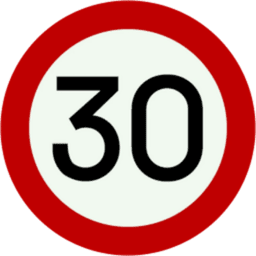
Indicates the maximum legal speed for the stretch of road. Drivers must not exceed the limit displayed on the sign.

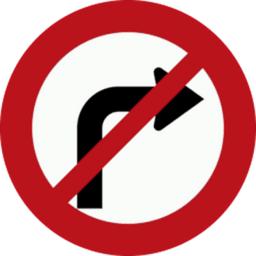
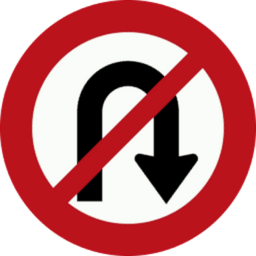
These signs prohibit specific turning movements at an intersection or stretch of road.
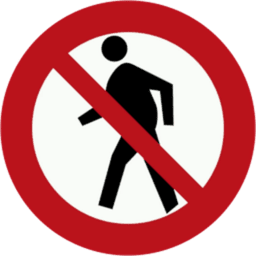
Pedestrian access is prohibited beyond this point. This area is restricted to vehicles only.
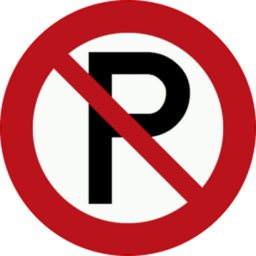
Vehicles may not be parked in areas marked with this sign.

Drivers may not stop, stand, or park in the marked area at any time, regardless of the reason. This includes stopping for loading or waiting.

Vehicles must proceed in the direction indicated by the arrow

Vehicles must keep to the side of the sign indicated by the arrow

Vehicles must not proceed onto the length of road for which this sign is posted
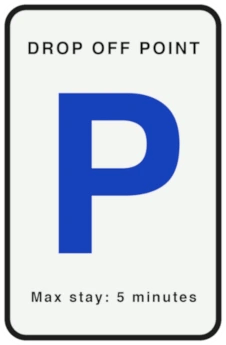
Parking in the marked area is permitted for a maximum of 5 minutes. Offenders may be charged under law 12.4 Parking.